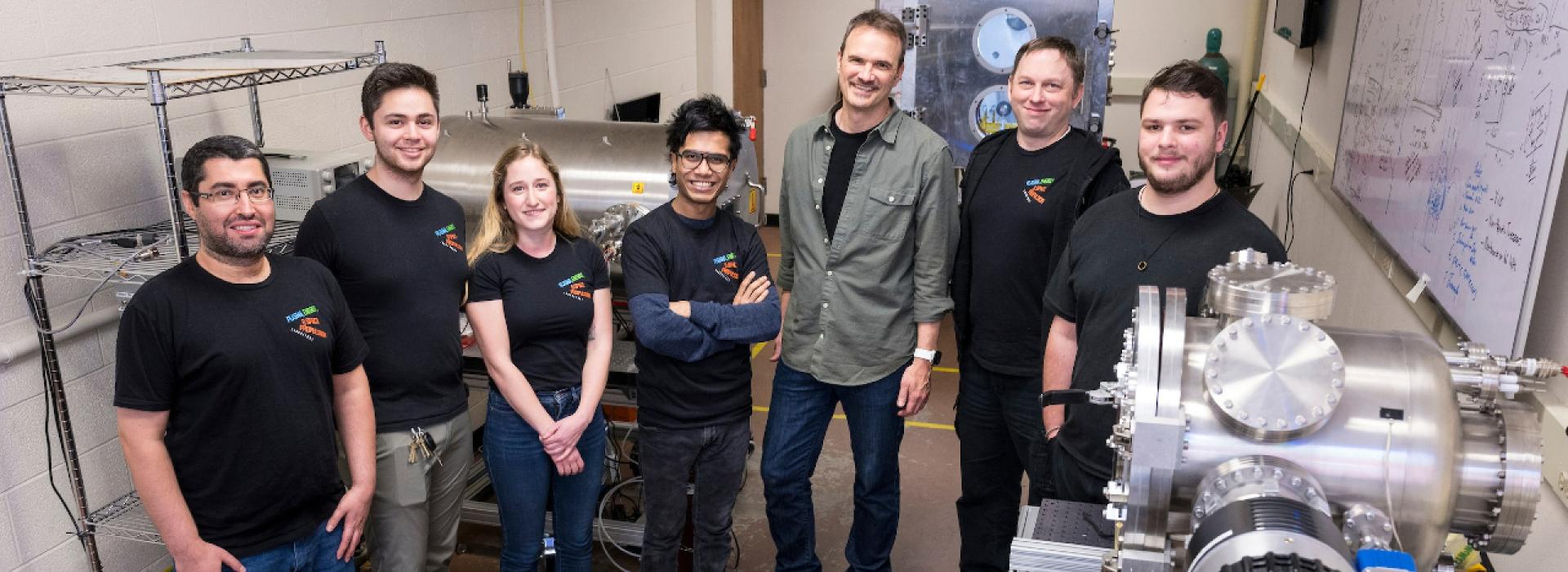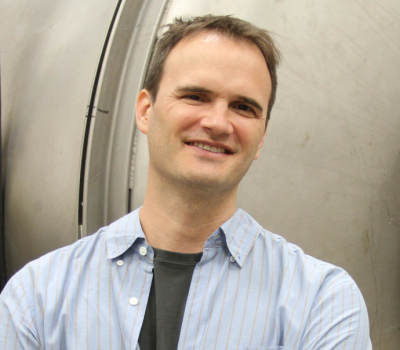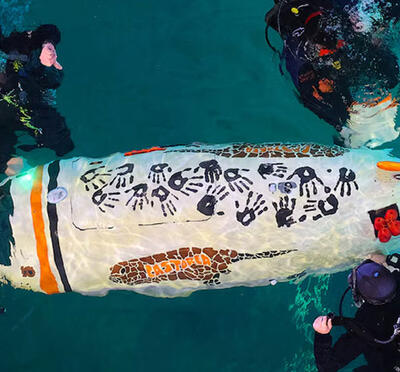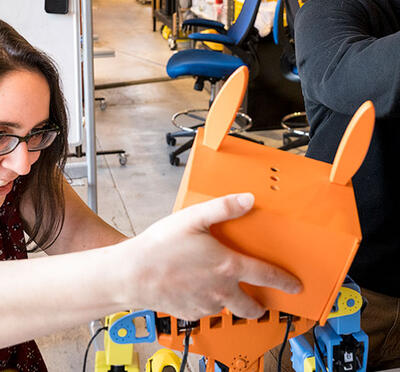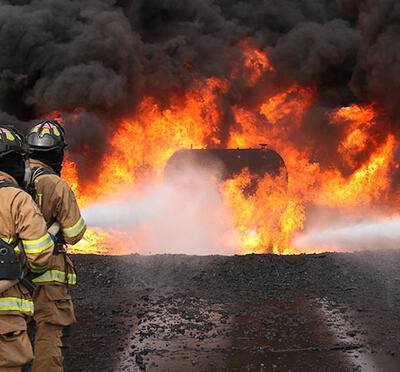Richard Wirz sometimes jokes that the word “aerospace” makes no sense.
“Aero means air, and space means the absence of air,” said Wirz, executive director for aerospace research programs and Boeing Professor of Mechanical Engineering Design at Oregon State University’s College of Engineering. “It’s like I study air and no air. Why are they even in the same category?”
The extremes, he says, reconcile the dichotomy.
“Everything we design and build for both realms has to operate in extreme conditions,” Wirz said. For aircraft, the extremes include high speeds, ferocious turbulence, structural stress, the intense temperatures of combustion, and the bone-numbing cold of high altitudes. For spacecraft, add even more speed, blistering heat from the Sun, wild temperature swings, vacuum, microgravity, jarring launch vibrations, and radiation to the inventory of threats — not to mention missions lasting years with (usually) no possibility for repairs.
Richard Wirz at Oregon State
Throughout his career, Wirz has sought to understand and overcome celestial and earthbound extremes by exploring fields like spacecraft propulsion, fusion energy, and materials development. (He’s also made breakthroughs in cancer treatment.)
Wirz joined the College of Engineering in 2022 with plans to scale up its burgeoning aerospace program and expand opportunities for student researchers. Previously, he had pursued aerospace research for more than 20 years, most notably at UCLA, Caltech, and NASA’s Jet Propulsion Laboratory. Among his primary research interests are plasma-material interactions and spacecraft electric propulsion.
Electric Propulsion Research
Electric propulsion, the fastest growing category of spacecraft propulsion, includes systems such as plasma propulsion engines or ion engines, which both operate on the same principle. The 5,400-plus Starlink communications satellites launched by SpaceX, for example, use a subset of ion engines called Hall-effect thrusters. In Hall thrusters, the propellant (usually xenon gas) diffuses into an annular chamber. Electrons trapped in a strong magnetic field at the downstream end of the chamber ionize the xenon, creating a plasma that’s accelerated by an electric field out of the engine at 15-30 kilometers per second.
Yet the thrust is minuscule. While firebreathing, chemically powered launch vehicles burn furiously for a few minutes and rapidly accelerate their payloads to dizzying orbital speeds, a typical ion engine produces the equivalent of a persistent gentle breeze with enough force to keep a single sheet of notebook paper aloft. EP-powered spacecraft may take weeks, even months, to reach interplanetary travel speeds, but their efficiency is unmatched.
“Once you get into orbit, you can use plasma thrusters to push yourself around with one-tenth of the propellant that a chemical rocket needs for the same maneuver,” Wirz said. “If you want to go really far into space, you want plasma propulsion.”
Developing New Electric Propulsion Technology with NASA
Wirz is Oregon State’s lead principal investigator in a sprawling, NASA-funded program to develop new, high-powered EP technology for large spacecraft transporting science experiments, people, and cargo in Earth orbit and to the Moon, Mars, and beyond. The agency’s five-year, $15 million Joint Advanced Propulsion Institute, or JANUS, comprises 17 research groups at 11 partner universities. Oregon State’s share of the grant is $2.25 million.
As the head of physics-based modeling and integration for JANUS, Wirz and his team of faculty researchers, graduate students, and postdocs are focused on developing and testing new EP thruster designs, developing novel testing apparatus and diagnostic systems, and studying long- term performance over the tens of thousands of hours that a thruster must operate during a typical interplanetary mission.
“To help us understand how higher-power EP systems operate in space, we’ll test them in large vacuum chambers, but that’s always been challenging,” Wirz said. “Plasma thrusters are intended for space, and they’re so powerful that they simply don’t behave the same way in even the most advanced vacuum chambers. Our plan is to integrate experimental work with physics-based, predictive engineering models to compensate for the effects of ground-based testing.”
Working with Plasma Thrusters
During prior research on plasma thrusters, Wirz recognized that inadequate materials represent a major obstacle to optimizing ion engine performance. In one troublesome phenomenon known as sputtering, the plasma erodes the thruster walls — an intolerable consequence in engines that may need to run continuously for years.
One promising approach to curtailing the damage is the use of foam-like substances that are designed and manufactured for extreme plasma conditions. This new class of materials, initially developed in Wirz’s lab, are called volumetrically complex materials, or VCMs. In electric propulsion, VCMs are characterized by a high-temperature metal permeated with a network of interconnected voids and pores. When exposed to intense plasma for long periods, VCMs not only resisted the corrosive effects of its high-energy ions; they actually absorbed some of the plasma, creating a multiphase material called a plasma-infused foam. Depending on conditions, VCMs can reduce sputtering by 80%-95%.
Plasma-infused foams may also decrease sputtering in fusion reactors — a potentially unlimited source of carbon-free energy technology in the very early stages of development. Wirz began investigating the possibilities in a Department of Energy-funded study called Robust Electrodes, or AMPERE. Plasmas generated during fusion are so intense, he explained, that fusion energy will become viable only through the emergence of materials that are supremely resilient to their potentially devastating power. The work, initiated at UCLA, has continued at Oregon State.
“There’s a lot of synergy between energy research for aerospace and for power generation,” Wirz said. “The problems in both are similar: We need to run things at higher temperatures and at extreme plasma conditions.”
Advanced Manufacturing of Graded and Tailored Alloys
New materials development is also at the core of another Oregon State study, funded by the Air Force: Advanced Manufacturing of Graded and Tailored Alloys and Composites. Its aim is to fabricate materials capable of surviving in environments that challenge the performance of conventional metal alloys, such as those found in jet engines and plasma propulsion thrusters, and which are expected in next-generation aircraft.
The university has so far received $8.8 million for the two-year project. Wirz, one of the study’s co-principal investigators, anticipates that total funding will reach $20 million.
To meet the military’s exacting performance standards, the university’s additive manufacturing technology and talent will be put to the test.
“We’ll leverage existing strengths at Oregon State, which is a leader in advanced materials and manufacturing,” Wirz said. “My role is to work with our materials scientists and manufacturing people and say ‘Here are the energy and aerospace needs. Can you make this material stronger and lighter? Can you make it more thermally conductive and more robust for the space or plasma environment?’”
Eventually, much of Wirz’s research will be conducted at his new Plasma, Energy, and Space Propulsion Lab, which is being built out and equipped at the Nancy Squires Aerospace Lab. He expects it to open within a year.
“I want it to be a cooperative setting where faculty, graduate students, and postdoctoral researchers join me for the ride, because it’s a lot more fun and a lot more productive to work together than to go it alone,” Wirz said. “Oregon State’s collaborative culture is a big reason why I’m here.”
He also underscores the interdisciplinary nature of aerospace research.
“Of course we need engineers, but we also need scientists to develop the payloads that go into space, to formulate and build new energy systems, to tell us how to monitor forests and oceans from orbit, or to determine the best ways to look at other planets,” Wirz said. “This is science and engineering together, and we would like many different specialties involved. That’s what will drive discovery here.”
